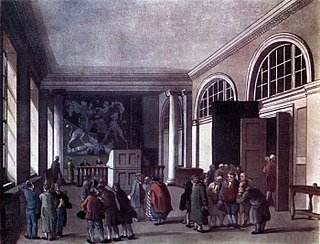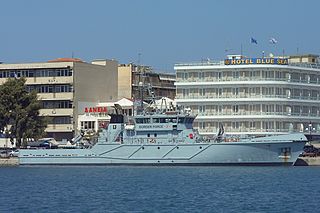
A coast guard or coastguard is a maritime security organization of a particular country. The term embraces wide range of responsibilities in different countries, from being a heavily armed military force with customs and security duties to being a volunteer organization tasked with search and rescue without law enforcement authority. In most countries, a typical coast guard's functions are distinct from those of the navy and the transit police, while in certain countries has similarities to both.

HM Customs and Excise was a department of the British Government formed in 1909 by the merger of HM Customs and HM Excise; its primary responsibility was the collection of customs duties, excise duties, and other indirect taxes.

HM Revenue and Customs is a non-ministerial department of the UK Government responsible for the collection of taxes, the payment of some forms of state support, the administration of other regulatory regimes including the national minimum wage and the issuance of national insurance numbers. HMRC was formed by the merger of the Inland Revenue and HM Customs and Excise, which took effect on 18 April 2005. The department's logo is the St Edward's Crown enclosed within a circle. Prior to the Queen's death on 8 September 2022, the department was known as Her Majesty's Revenue and Customs and has since been amended to reflect the change of monarch.

A customs officer is a law enforcement agent who enforces customs laws, on behalf of a government.

HM Customs was the national Customs service of England until a merger with the Department of Excise in 1909. The phrase 'HM Customs', in use since the Middle Ages, referred both to the customs dues themselves and to the office of state established for their collection, assessment and administration.

United States Coast Guard Cutter is the term used by the U.S. Coast Guard for its commissioned vessels. They are 65 feet (19.8 m) or greater in length and have a permanently assigned crew with accommodations aboard. They carry the ship prefix USCGC.

His or Her Majesty's Excise refers to 'inland' duties levied on articles at the time of their manufacture. Excise duty was first raised in England in 1643. Like HM Customs, the Excise was administered by a Board of Commissioners who were accountable to the Lords Commissioners of the Treasury. While 'HM Revenue of Excise' was a phrase used in early legislation to refer to this form of duty, the body tasked with its collection and general administration was usually known as the Excise Office.
A number of vessels of the British revenue services, at times known as the Inland Revenue, HM Customs and Excise, HM Revenue and Customs, and most recently UK Border Agency, have been named Vigilant:

HMC Vigilant is a Border Agency (customs) cutter of the United Kingdom. She was launched by Damen Shipyards in the Netherlands in 2003 and is one of four 42-metre (138 ft) cutters operated by the UK Border Force.

HMC Valiant is a Border Force (customs), formerly UK Border Agency, cutter of the United Kingdom. She was launched by Damen Shipyards in the Netherlands in 2003 and is one of four 42-metre (138 ft) cutters formerly operated by Her Majesty's Revenue and Customs, and since 2008 operated by the UK Border Agency and after its dissolution in 2013 operated by the UK Border Force.

The UKBF 42m Customs Cutter, formerly HMRC 42m Customs Cutter & UKBA 42m Customs Cutter, is a class of four patrol vessels, derived from the Dutch Damen Stan Patrol 4207 design, operated by the UK Border Force.

HMC Seeker is a Border Agency (customs) cutter of the United Kingdom. She was launched by Damen Shipyards in the Netherlands in 2001 and is one of four 42-metre (138 ft) cutters formerly operated by HM Revenue and Customs, then from 2008 she was operated by the UK Border Agency and after its dissolution in 2013 operated by the Border Force.

The Dutch shipbuilding firm The Damen Group, designs and manufactures a wide variety of vessels, including a range of related patrol vessels known generally as the Damen Stan Patrol vessels.

HMBS Leonard C Banfield is patrol vessel of the Barbados Coast Guard. She was commissioned on 14 September 2007. She is built to the design of the Damen Group's Stan 4207 patrol vessel, a class of 42-metre (138 ft) 240 ton vessels.

Border Force (BF) is a law-enforcement command within the Home Office, responsible for frontline border control operations at air, sea and rail ports in the United Kingdom. The force was part of the now defunct UK Border Agency from its establishment in 2008 until Home Secretary Theresa May demerged it in March 2012 after severe criticism of the senior management.

Australian Border Force Cutter (ABFC) Ocean Shield is an offshore patrol vessel operated by the Australian Border Force. The ship was originally ordered in 2010 by DOF Subsea as an offshore support vessel, and was laid down by STX OSV as MSV Skandi Bergen in 2011. In 2012, the Australian Department of Defence was seeking a short-term replacement for the decommissioned Kanimbla-class amphibious landing ships, and negotiated to purchase the under-construction Skandi Bergen from DOF Subsea. The ship was completed, and entered Royal Australian Navy (RAN) service in mid-2012 as the civilian-crewed Australian Defence Vessel (ADV) Ocean Shield.

HMC Sentinel was a patrol ship operated by the Border Force in the role of patrolling the waters of the United Kingdom. It is a Vosper Thornycroft 'Island Class' vessel and was commissioned in 1993.

HMC Protector is a Border Force (customs) cutter of the United Kingdom, formerly the Tavi of the Finnish Border Guard. She was built by Uki Workboat in Finland and was acquired by the UK Border Force in 2013. After a period of refit, the vessel was commissioned by the then Home Secretary Theresa May on 17 March 2014. Protector replaced HMC Sentinel, which was retired in 2013.

Iliria-class patrol vessels is a Albanian Coast Guard class of patrol vessels, that is based on the Damen Stan 4207 patrol vessel design. The first ship of this class Iliria, from which the class takes its name, was produced in Gorinchem, Netherlands by Damen Group and was commissioned in 2008. The other three vessels were built locally starting from 2009 to 2014 in Albania by the state-owned Pashaliman Shipyard. Over a dozen navies, coast guards and other government agencies operate vessels based on this design. While some of those vessels are equipped for purely civilian patrols, the Albanian ships are armed with a remote-controlled 20mm Nexter M621 NARWHAL cannon.


















